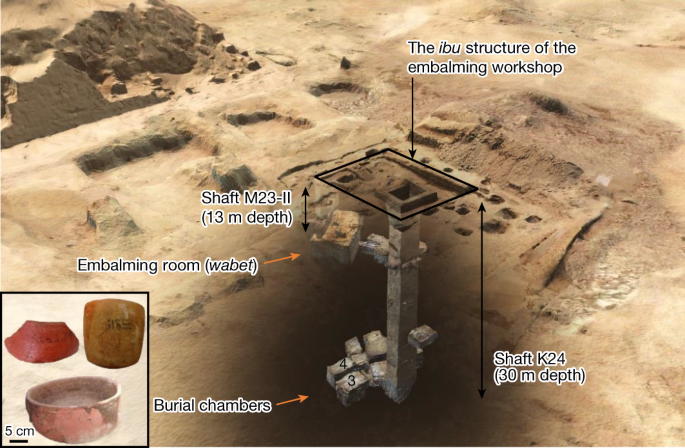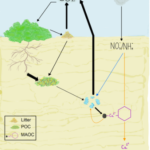LMUとテュービンゲン大学の国際研究チームが、古代エジプトの防腐処理の秘密を解き明かそうとしています。サッカラの工房から出土した容器から、人体保存に使用されていた物質について新たな知見が得られています。 A international team of researchers from LMU and University of Tübingen is unveiling the secrets of ancient Egyptian embalming. Vessels from a workshop in Saqqara are providing new insights into the substances that were used to preserve human bodies
2023-02-01 ミュンヘン大学(LMU)
◆LMUミュンヘンとテュービンゲン大学の研究チームは、カイロの国立研究センターと共同で、2016年まで発見されていなかったサッカラ(ウナスのピラミッドからそう遠くない)の防腐処理工房の容器に残留する化学物質を分析しました。
◆新たに発見された工房では、専門家が紀元前7〜6世紀の死者をミイラにしていた。エジプト学者にとって、大昔に熟練工が使っていた数々の器を復元できたことは、大変な幸運だった。しかも、その器には当時の内容が記されたラベルが貼られ、中には使い方が書かれたものまであった。「発掘調査を率いるテュービンゲン大学のスザンネ・ベック氏は、「古代エジプトの文献が解読されたときから、防腐剤の名前はわかっていたんです。「しかし、これまでは、それぞれの名称の背後にある物質が何であるかを推測することしかできませんでした」。
◆容器に残留する化学物質を分析することで、かつてその容器に使われていた物質の分子的な残骸を分離・同定することができるようになったのです。謎が解き明かされるにつれ、いくつもの驚きがあった。チュービンゲン大学の考古学者で、分析プロジェクトの責任者であるマキシム・ラゴーは、その一つを明らかにする。「古代エジプト人がアンティウと名付けた物質は、長い間ミルラやフランキンセンスと訳されてきました。しかし、我々は今、それが実際には大きく異なる成分の混合物であることを示すことができ、ガスクロマトグラフィー/質量分析の助けを借りて、それを分解することができました。” サッカラで使われていたアンティウは、スギ油、ビャクシン油、動物性油脂の混合物であった。
◆ピスタチオ樹脂、スギ油、アスファルト(いずれもレバント地方のものと思われる)のほかに、ダンマルゴムやエレミ樹脂の残留物も発見された。特にこの2つの物質は、約3000年前にすでに貿易関係がいかにグローバル化していたかを示している。エレミの樹脂は熱帯アフリカや東南アジアからエジプトにもたらされたが、ダンマルは現在でも熱帯の東南アジアにしか生えていない。このように、防腐処理に使用する化学物質の調達には、多大な努力が払われたことがわかる。
<関連情報>
- https://www.lmu.de/en/newsroom/news-overview/news/the-chemistry-of-mummification—traces-of-a-global-network.html
- https://www.nature.com/articles/s41586-022-05663-4
生体分子解析により、古代エジプトの防腐処理に新たな知見 Biomolecular analyses enable new insights into ancient Egyptian embalming
Maxime Rageot,Ramadan B. Hussein,Susanne Beck,Victoria Altmann-Wendling,Mohammed I. M. Ibrahim,Mahmoud M. Bahgat,Ahmed M. Yousef,Katja Mittelstaedt,Jean-Jacques Filippi,Stephen Buckley,Cynthianne Spiteri & Philipp W. Stockhammer
Nature Published:01 February 2023
DOI:https://doi.org/10.1038/s41586-022-05663-4

Abstract
The ability of the ancient Egyptians to preserve the human body through embalming has not only fascinated people since antiquity, but also has always raised the question of how this outstanding chemical and ritual process was practically achieved. Here we integrate archaeological, philological and organic residue analyses, shedding new light on the practice and economy of embalming in ancient Egypt. We analysed the organic contents of 31 ceramic vessels recovered from a 26th Dynasty embalming workshop at Saqqara1,2. These vessels were labelled according to their content and/or use, enabling us to correlate organic substances with their Egyptian names and specific embalming practices. We identified specific mixtures of fragrant or antiseptic oils, tars and resins that were used to embalm the head and treat the wrappings using gas chromatography–mass spectrometry analyses. Our study of the Saqqara workshop extends interpretations from a micro-level analysis highlighting the socio-economic status of a tomb owner3,4,5,6,7 to macro-level interpretations of the society. The identification of non-local organic substances enables the reconstruction of trade networks that provided ancient Egyptian embalmers with the substances required for mummification. This extensive demand for foreign products promoted trade both within the Mediterranean8,9,10 (for example, Pistacia and conifer by-products) and with tropical forest regions (for example, dammar and elemi). Additionally, we show that at Saqqara, antiu and sefet—well known from ancient texts and usually translated as ‘myrrh’ or ‘incense’11,12,13 and ‘a sacred oil’13,14—refer to a coniferous oils-or-tars-based mixture and an unguent with plant additives, respectively.



